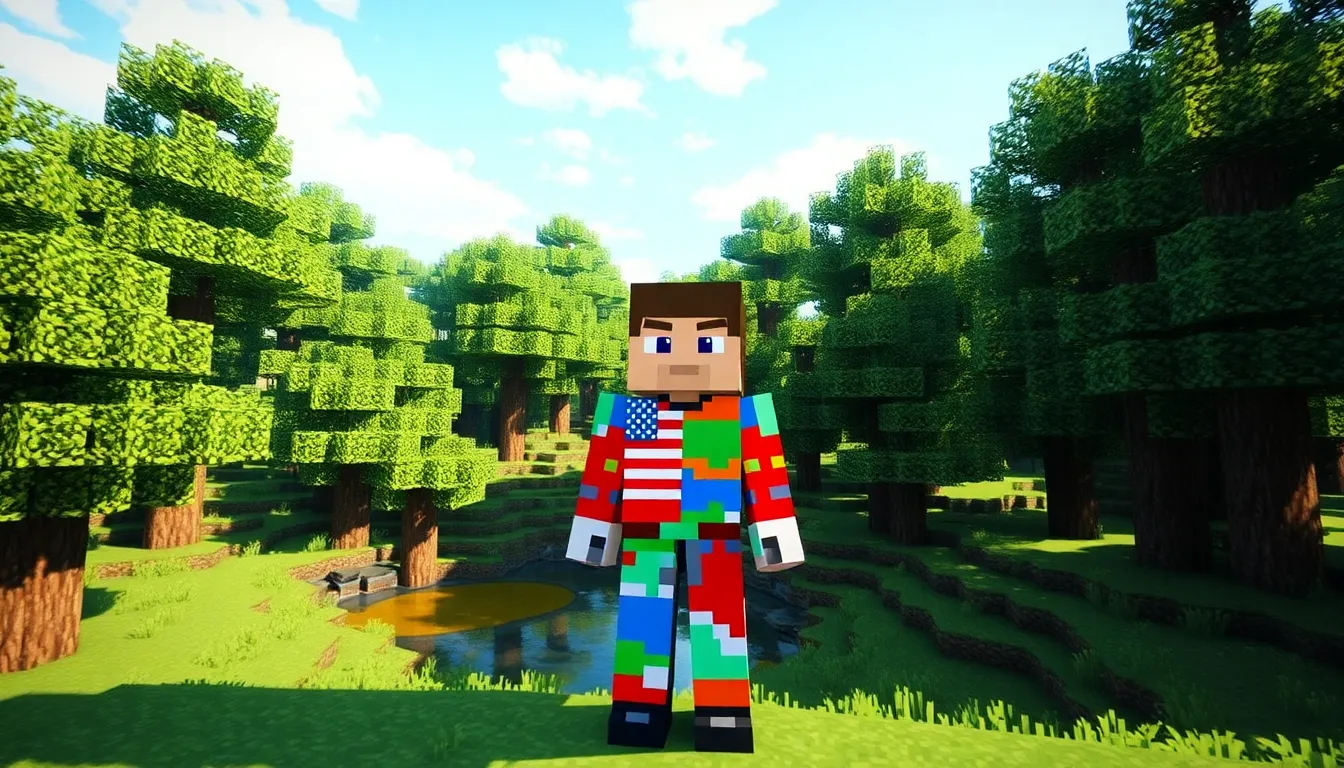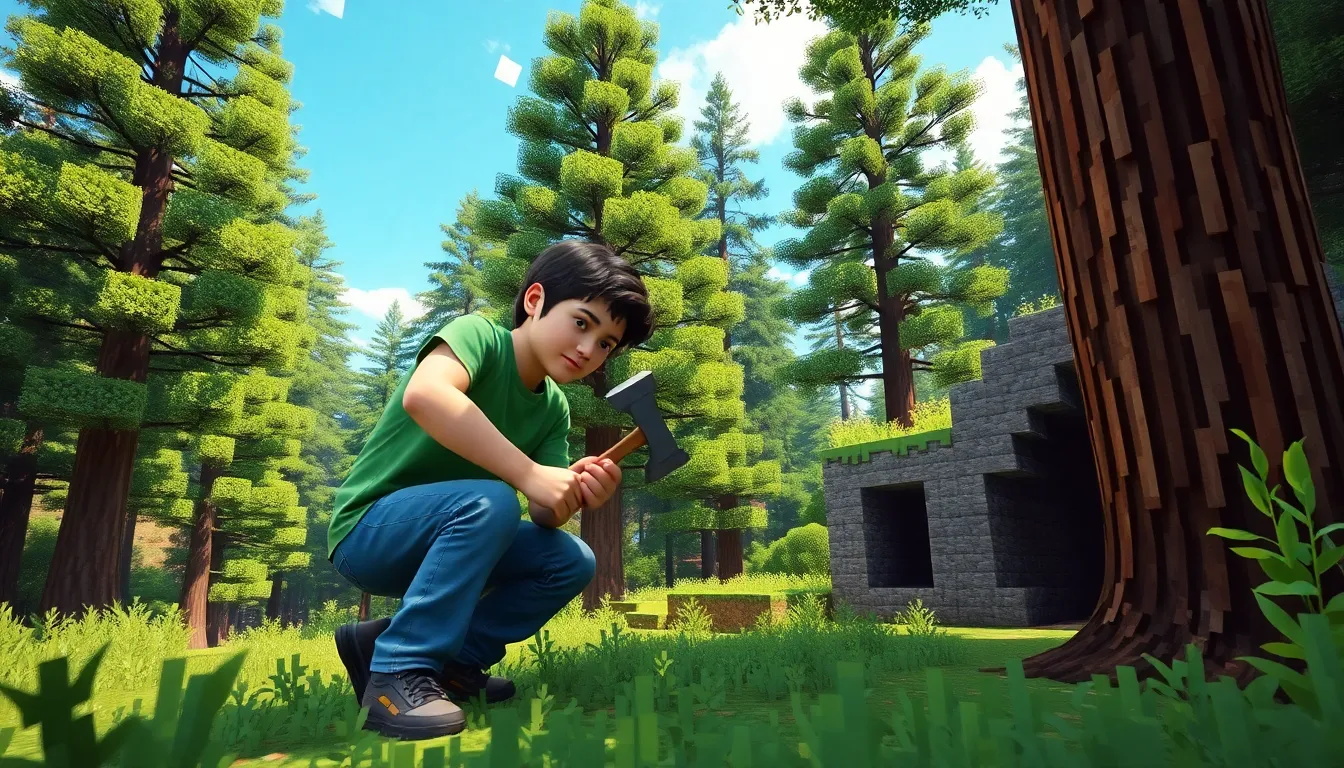Table of Contents
ToggleIn the pixelated world of Minecraft, survival isn’t just a game; it’s an art form. Whether you’re a newbie fumbling with your first wooden pickaxe or a seasoned player ready to tackle the Ender Dragon, mastering the essentials can mean the difference between thriving and becoming a zombie’s next meal.
Overview of Minecraft Survival Guide
Minecraft survival requires players to utilize various skills and strategies. Mastering resource gathering becomes essential; players collect wood, stone, and food to establish a solid foundation. Establishing a shelter protects against monsters, especially at night, when threats like zombies spawn.
Exploring the biomes introduces players to diverse resources. Deserts harbor cacti, while forests provide valuable wood and animals. Crafting tools enhances efficiency; players create pickaxes or axes to gather materials faster. Managing health and hunger also plays a crucial role; players should prioritize food sources for sustenance.
Creating armor and weapons contributes to survival. Players can craft iron swords or diamond armor to defend against hostile mobs effectively. Understanding the significance of enchanting equipment adds an advanced layer to gameplay that improves combat and resource management.
Building farms ensures a steady food supply. Players grow crops such as wheat or carrots, supporting long-term survival. Engaging in fishing or animal husbandry extends food options as well.
Cooperation with other players in multiplayer mode enhances survival chances. Forming alliances allows for shared resources and protection against threats. Players develop community areas, enhancing safety and enriching the overall experience.
Utilizing maps and coordinates aids navigation. Players can mark important locations, such as villages or resource-rich areas, streamlining their exploration efforts. Strategies for overcoming challenges involve careful planning and exploitation of the in-game environment.
Mastering the art of survival in Minecraft hinges on resource management, crafting, and strategic planning. Adapting to challenges shapes the gameplay experience, guiding players toward success in their virtual adventures.
Getting Started

Starting in Minecraft involves making critical choices that shape the gameplay experience. Players can choose various paths, each offering unique challenges and rewards.
Choosing Your World Type
Selecting the right world type sets the stage for adventures. Minecraft offers several options like Survival, Creative, Hardcore, and Adventure modes. Survival mode emphasizes resource management and crafting, while Creative mode focuses on unlimited resources for building. Hardcore mode intensifies the experience with permanent death, appealing to those seeking a real challenge. Adventure mode allows players to enjoy custom maps in specific gameplay scenarios. Before diving in, consider which mode aligns with your gaming style and current goals.
Customizing Your Character
Customizing a character enhances gameplay immersion. Players can adjust their avatars through skins, which offer visual appeal while exploring. Access skin packs or create unique designs to reflect personal style. Changing appearance boosts engagement, making the game experience more enjoyable. Additionally, players may want to consider their names, as these can influence interactions with others in multiplayer settings. Unique characters and personal touches foster a deeper connection to the game environment.
Essential Resources
Survival in Minecraft relies heavily on accessing essential resources early in the game. Collecting the right materials helps lay a solid foundation for success.
Gathering Wood and Stone
Gathering wood and stone marks the first step toward survival. Trees in nearly every biome provide wood for crafting tools and building shelters. He can punch trees to collect logs, then craft them into planks. Stone, found typically underground or along mountain sides, serves as a critical resource for crafting stone tools. Players should use wooden pickaxes to mine stone quickly. Collecting at least 20 pieces of wood and 10 pieces of stone creates a strong initial stockpile, ensuring basic crafting needs are met. Gather these resources before nightfall to avoid threats from hostile mobs.
Crafting Tools and Weapons
Crafting tools and weapons transforms basic materials into essential survival gear. Players should prioritize crafting a crafting table to enhance their tool selection. With it, they can create upgraded tools like stone pickaxes, axes, and swords. Stone tools significantly improve the efficiency of resource gathering, making it easier to collect materials quickly. Creating weapons for protection against hostile mobs proves vital for survival. Prioritize crafting a sword for defense and an axe for cutting wood. Stronger tools combine with players’ skills, ensuring they remain well-equipped for challenges that arise in the world of Minecraft.
Building Your Shelter
Building an effective shelter is crucial for survival in Minecraft. It provides protection against hostile mobs and harsh weather conditions during nighttime.
Types of Structures
Players can choose from various types of structures for their shelters. Basic dirt huts offer quick protection, while wooden cabins provide durability. Stone houses ensure safety and resilience against mobs, including creepers. Players might also construct farms attached to their shelters for convenience. Treehouses provide camouflage, keeping players hidden from enemies. In mountainous areas, caves serve as natural shelters, allowing for easy resource access. Each structure type serves its purpose and can significantly enhance gameplay.
Tips for Energy Efficiency
To optimize energy efficiency, players should consider resource availability. Building near trees helps with easy access to wood, while proximity to water sources simplifies farming. Players can also use torches strategically to reduce the need for constant lighting. Crafting beds allows for skipping nights, conserving health and hunger. Efficient designs minimize material use, with compact layouts reducing the need for excess resources. Storing supplies in close proximity enhances resource management, saving time and energy during gameplay.
Food and Health Management
Managing food and health is crucial for survival in Minecraft. Hunger depletes over time, affecting players’ health and abilities. Players must prioritize food sources to maintain their energy levels.
Farming Basics
Creating a farm lays the foundation for a reliable food supply. Players can begin by planting seeds obtained from grass or harvesting crops. Wheat, carrots, and potatoes serve as excellent early-game options. Watering crops with adjacent water blocks boosts their growth rate. Building a fence around the farm prevents animals from trampling the crops. Harvesting the crops when fully grown ensures a steady food supply for future endeavors. Establishing multiple farms for different crops ensures variety in diet, promoting health and vitality.
Cooking and Food Preservation
Cooking food enhances its benefits, restoring more hunger points than raw alternatives. Players can utilize furnaces or campfires for cooking various items like meat and vegetables. Cooked meat provides greater health recovery, crucial in combat or exploration scenarios. For long-term sustenance, players can preserve food by crafting items such as cakes or golden apples. These items replenish hunger more effectively and provide added advantages. Packaging food in chests or creating farms for continuous crop growth ensures that players maintain their health efficiently throughout their adventures.
Exploring the Environment
Exploring the environment in Minecraft plays a crucial role in survival. Players encounter diverse biomes, each offering unique resources and challenges.
Biomes and Their Differences
Biomes vary significantly in their terrain and resources. Forests provide wood and wildlife for easy hunting, while deserts lack vegetation but may contain valuable temples. Mountains offer minerals such as coal and iron, essential for crafting tools. Savannas feature quick access to abundant animal life, aiding in food supply. Each biome’s climate influences player strategies and resource management. Understanding these differences aids in optimizing exploration efforts. Travelers should remember to gather materials from multiple biomes to enhance their survival capabilities.
Finding Rare Resources
Finding rare resources often requires exploration into deep caves and mountainous regions. Players encounter valuable minerals like diamonds and emeralds, which enhance their gear significantly. Searching at specific Y-levels increases the likelihood of discovering these precious items; for example, diamonds spawn most frequently between Y-levels 5 and 12. Caves present opportunities for mining and can provide access to essential items like redstone and gold. Using tools like enchanted pickaxes boosts efficiency in gathering rare resources. Venturing into unexplored territories often rewards players with the best items, making strategic exploration necessary for survival.
Combat and Defense Strategies
Survival in Minecraft heavily relies on effective combat and defense strategies. Players must understand threats and prepare accordingly.
Understanding Hostile Mobs
Hostile mobs, like zombies, skeletons, and creepers, pose significant dangers. Each mob has unique behaviors and strengths, requiring different tactics. Zombies swarm players at night; knowledge of their patterns aids avoidance. Skeletons attack from a distance with arrows, making cover essential. Creepers explode upon proximity, emphasizing the importance of keeping distance. Observing these mobs and learning their spawning locations enhances readiness. Players should engage mobs strategically, using well-equipped weapons for efficiency. Utilizing light sources, such as torches, can deter their spawning, allowing safer exploration during nighttime.
Building Defenses
Building effective defenses offers protection against hostile mobs. Structures provide refuge, with walls and roofs being fundamental. Players often use blocks like stone and wood to create barriers. Reinforced shelters minimize damage from attacks, making survival more manageable. Incorporating traps, like pitfalls or hidden lava, can also deter mobs. Ultimately, setting up a secure perimeter around a base safeguards against invasions. Players should prioritize entrances, utilizing doors or trapdoors for accessibility. Strong designs facilitate better defense while ensuring easy player movement, optimizing survival.
Surviving in Minecraft is about more than just staying alive; it’s about creativity and strategy. Players who embrace the various skills and techniques discussed will find themselves better equipped to tackle the challenges the game presents. By mastering resource gathering crafting effective tools and building strong shelters they can create a thriving environment.
As they explore diverse biomes and manage their health and hunger players will discover the joy of Minecraft’s endless possibilities. Engaging with the game’s mechanics and collaborating with others enhances the experience making survival a true adventure. With dedication and practice anyone can transform their gameplay into a successful survival journey.





